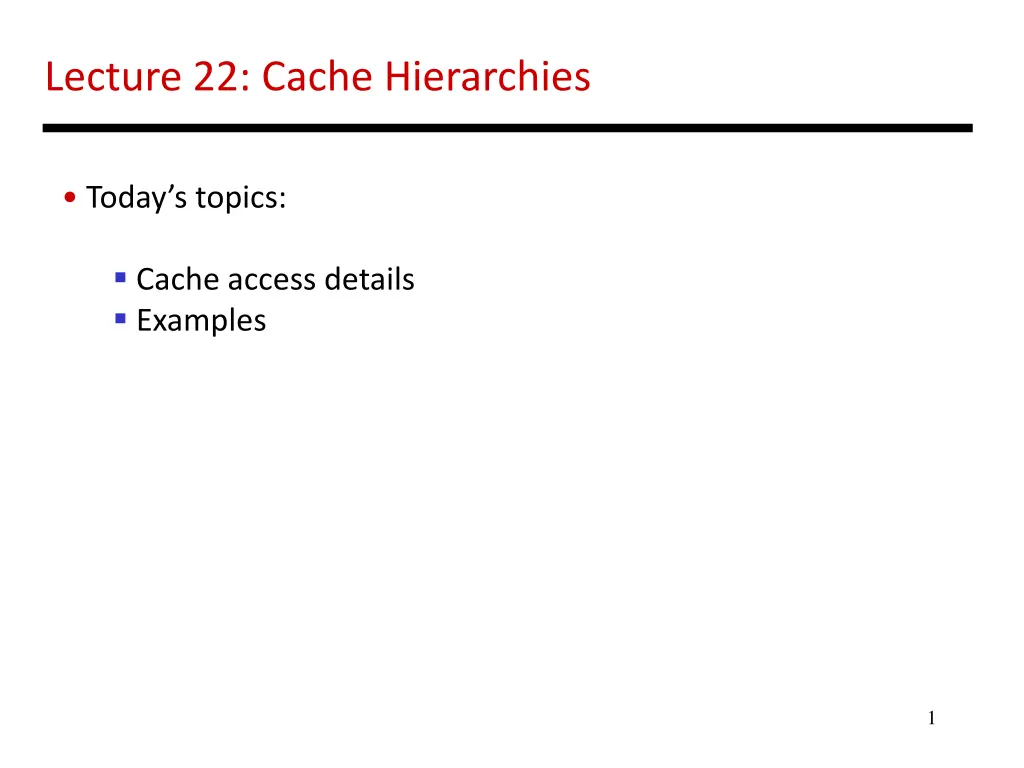
Understanding Cache Hierarchies: Access Details and Examples
Explore cache hierarchies in today's lecture, diving into cache access details and examples. Learn about accessing the cache, tag array, example access patterns, increasing line size, associativity, and more. Understand the impact of cache line sizes, set associativity, and ways in optimizing cache performance for various applications.
Download Presentation

Please find below an Image/Link to download the presentation.
The content on the website is provided AS IS for your information and personal use only. It may not be sold, licensed, or shared on other websites without obtaining consent from the author. If you encounter any issues during the download, it is possible that the publisher has removed the file from their server.
You are allowed to download the files provided on this website for personal or commercial use, subject to the condition that they are used lawfully. All files are the property of their respective owners.
The content on the website is provided AS IS for your information and personal use only. It may not be sold, licensed, or shared on other websites without obtaining consent from the author.
E N D
Presentation Transcript
Lecture 22: Cache Hierarchies Today s topics: Cache access details Examples 1
Accessing the Cache Byte address 101000 Offset 8-byte words 8 words: 3 index bits Direct-mapped cache: each address maps to a unique location in cache Sets Data array 3
The Tag Array Byte address 101000 Tag 8-byte words Compare Direct-mapped cache: each address maps to a unique address Tag array Data array 4
Example Access Pattern Byte address Assume that addresses are 8 bits long How many of the following address requests are hits/misses? 4, 7, 10, 13, 16, 68, 73, 78, 83, 88, 4, 7, 10 101000 Tag 8-byte words Compare Direct-mapped cache: each address maps to a unique address Tag array Data array 5
Increasing Line Size A large cache line size smaller tag array, fewer misses because of spatial locality Byte address 10100000 32-byte cache line size or block size Tag Offset Tag array Data array 6
Associativity Set associativity fewer conflicts; wasted power because multiple data and tags are read Byte address 10100000 Tag Way-1 Way-2 Tag array Data array Compare 7
Associativity How many offset/index/tag bits if the cache has 64 sets, each set has 64 bytes, 4 ways Byte address 10100000 Tag Way-1 Way-2 Tag array Data array Compare 8
Example 1 32 KB 4-way set-associative data cache array with 32 byte line sizes How many sets? How many index bits, offset bits, tag bits? How large is the tag array? Cache size = #sets x #ways x blocksize Index bits = log2(sets) Offset bits = log2(blocksize) Addr width = tag + index + offset 9
Example 1 32 KB 4-way set-associative data cache array with 32 byte line sizes cache size = #sets x #ways x block size How many sets? 256 How many index bits, offset bits, tag bits? 8 5 19 log2(sets) log2(blksize) addrsize-index-offset How large is the tag array? tag array size = #sets x #ways x tag size = 19 Kb = 2.375 KB 10
Example 2 Show how the following addresses map to the cache and yield hits or misses. The cache is direct-mapped, has 16 sets, and a 64-byte block size. Addresses: 8, 96, 32, 480, 976, 1040, 1096 Offset = address % 64 (address modulo 64, extract last 6) Index = address/64 % 16 (shift right by 6, extract last 4) Tag = address/1024 (shift address right by 10) 32-bit address 22 bits tag 4 bits index 6 bits offset 8: 0 0 8 M 96: 0 1 32 M 32: 0 0 32 H 480: 0 7 32 M 976: 0 15 16 M 1040: 1 0 16 M 1096: 1 1 8 M . . . 11
Example 3 A pipeline has CPI 1 if all loads/stores are L1 cache hits 40% of all instructions are loads/stores 85% of all loads/stores hit in 1-cycle L1 50% of all (10-cycle) L2 accesses are misses Memory access takes 100 cycles What is the CPI? 12
Example 3 A pipeline has CPI 1 if all loads/stores are L1 cache hits 40% of all instructions are loads/stores 85% of all loads/stores hit in 1-cycle L1 50% of all (10-cycle) L2 accesses are misses Memory access takes 100 cycles What is the CPI? Start with 1000 instructions 1000 cycles (includes all 400 L1 accesses) + 400 (ld/st) x 15% x 10 cycles (the L2 accesses) + 400 x 15% x 50% x 100 cycles (the mem accesses) = 4,600 cycles CPI = 4.6 13
Example 4 Assume that addresses are 8 bits long How many of the following address requests are hits/misses? 4, 7, 10, 13, 16, 24, 36, 4, 48, 64, 4, 36, 64, 4 Byte address 00010000 Tag Way-1 Way-2 8-byte blocks Tag array Data array 14
Example 4 Assume that addresses are 8 bits long How many of the following address requests are hits/misses? 4, 7, 10, 13, 16, 24, 36, 4, 48, 64, 4, 36, 64, 4 M H M H M M M H M M H M M M Byte address 00010000 Tag Way-1 Way-2 8-byte blocks Tag array Data array 15
